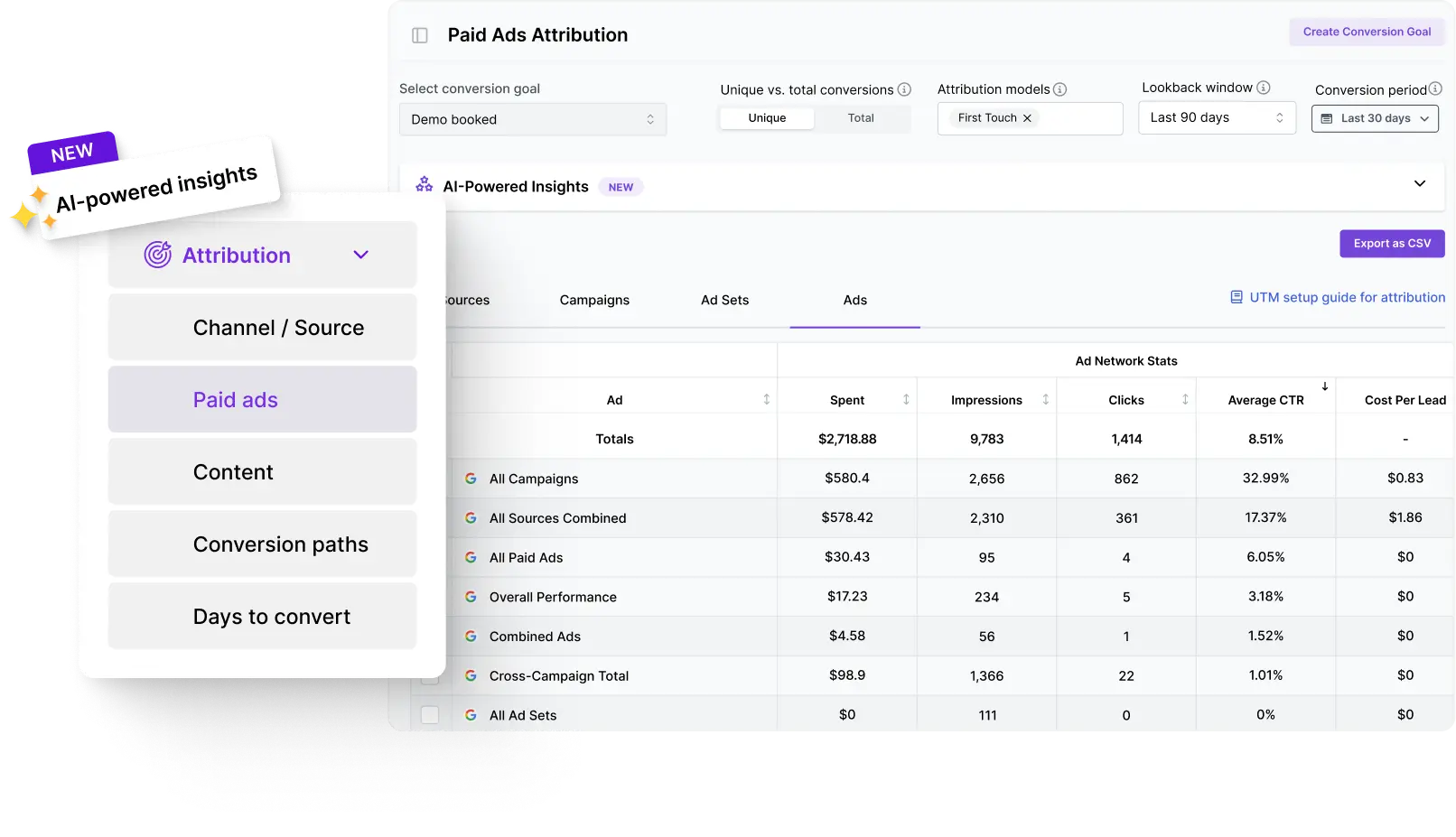What is ROAS?
Return on ad spend (ROAS) is a marketing metric that measures the revenue generated for every dollar spent on advertising. It helps marketers evaluate the effectiveness of their advertising campaigns and determine whether they are generating enough revenue to justify the ad spend.
ROAS formula:

In this formula, "Revenue from Ads" refers to the total income generated directly from your advertising efforts, while "Ad Spend" is the total amount spent on the campaign.
For example, If you spend $1,000 on one ad and generate $2,000 in revenue from that ad, your ROAS would be:

How to calculate ROAS with our free calculator?
Usermaven’s Free ROAS calculator simplifies the process of determining your return on ad spend. Here's how to use it:
- Input your ad spend
Enter the total amount you've spent on a specific ad campaign or marketing effort. - Enter your revenue
Include the total revenue generated from the ad campaign. - Get your ROAS
The calculator will compute your ROAS, showing how much revenue you earned for every dollar spent.
What is a good ROAS?
A good ROAS (return on ad spend) typically means you're generating significantly more revenue than you're spending on advertising. While benchmarks vary by industry, a ROAS of 4:1 is often considered strong, this means earning $4 in revenue for every $1 spent on ads.
However, what's considered “good” can depend heavily on your business model, customer lifetime value, and profit margins. For instance, a high-margin product might be profitable with a lower ROAS, whereas a business with thin margins may need a much higher ROAS to break even or scale. Always evaluate ROAS in the context of your broader financial goals.
Why is ROAS calculation important?
Calculating ROAS is crucial for several reasons:
- Campaign performance: It reveals how effective your ad spend is at generating revenue.
- Budget optimization: Helps allocate your ad budget to the best-performing channels.
- Marketing strategy refinement: Provides insights to tweak campaigns for better results.
- Return maximization: Ensures every dollar spent is working hard to boost your revenue.
Key features of an effective ROAS calculator
An effective ROAS calculator offers a straightforward way to evaluate the performance of your ad spend by delivering clear, accurate results in real time. It simplifies the decision-making process for marketers, helping them optimize budgets and strategies with confidence. Here are some of the key features of an effective ROAS calculator:
- Simple inputs: Quickly enter ad spend and revenue without confusion or extra steps.
- Instant calculation: Get your ROAS percentage instantly with no delays or manual math.
- Clear output format: View results in an easy-to-understand percentage, making performance analysis straightforward.
- No login required: Access the ROAS calculator instantly - no sign-ups, logins, or subscriptions needed.
- Mobile-friendly design: Use the ROAS calculator on desktop or mobile devices wherever you are.
- Guided instructions: Helpful tips or brief guides ensure even non-technical users can calculate ROAS easily.
- Privacy-first: No data storage or tracking, ensuring user input remains private and secure.
Factors that influence ROAS
- Ad spend: The more you invest in ads, the higher the potential return, but it requires careful targeting and optimization to see significant ROAS improvement.
- Ad creative and targeting: Well-designed ads with precise targeting increase the likelihood of generating higher revenue from your ad spend.
- Audience engagement: The level of engagement from your target audience plays a significant role in determining how effective your ad spend is in generating conversions.
- Campaign optimization: Continuous testing and optimization of ad campaigns are essential to improving ROAS over time.
- Market competition: In highly competitive markets, higher ad spend may be needed to generate the same return, potentially affecting your ROAS.
How to calculate break-even ROAS
Break-even ROAS is the point where your revenue from ads exactly covers your costs, no profit, no loss. To calculate it, you need to know your profit margin. The formula is:
Break-even ROAS = 1 / Profit margin
For example, if your profit margin is 25% (or 0.25), your break-even ROAS would be:
1 / 0.25 = 4
This means you need to generate $4 in revenue for every $1 spent on ads just to cover your costs. Knowing your break-even ROAS helps you set realistic ad spend goals and understand the minimum performance needed to stay profitable.
Common ROAS mistakes to avoid
- Overestimating returns: Failing to consider all costs, like creative production, ad platform fees, or testing, can lead to inflated ROAS figures.
- Not factoring in attribution delay: ROAS calculations often ignore the time it takes for a customer to convert after seeing an ad, leading to a distorted view of campaign performance.
- Neglecting campaign adjustments: Relying on initial ROAS numbers without regularly optimizing ads can result in missed opportunities for better returns.
- Ignoring customer lifetime value (CLV): Focusing only on immediate returns from ads, instead of considering long-term customer value, can lead to underestimating the true effectiveness of ad spend.
- Misunderstanding ROAS benchmarks: Comparing your ROAS to industry averages or competitors without considering your unique business context can lead to misguided conclusions.
Why does Usermaven’s free ROAS calculator stand out?
Usermaven’s free ROAS calculator is built for marketers, founders, and teams aiming to track ad performance without hassle. Whether you're testing new campaigns or scaling up spend, our tool offers:
- Ease of use: Simple input fields and instant results - no learning curve.
- Accuracy: Delivers precise ROAS percentage based on your real-time data.
- No sign-up required: Start calculating without creating an account.
- Privacy first: We don't store or track your inputs - your data stays yours.






